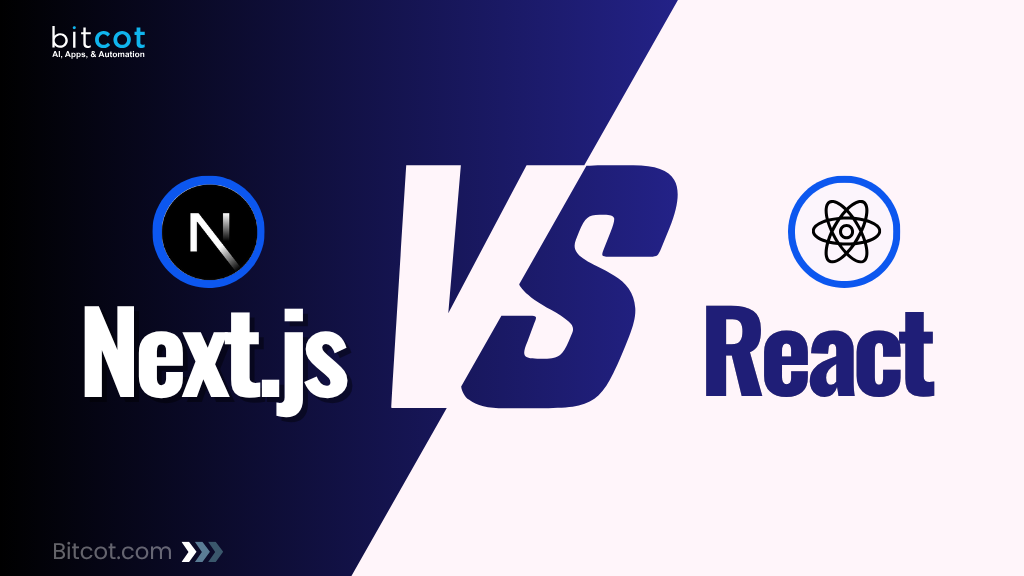
The framework you choose today will shape your digital growth for years to come.
You’ve already invested in a web application. But now, you’re seeing warning signs. Sluggish performance, weak SEO rankings, higher bounce rates, and increasing customer expectations are putting pressure on your current setup. Technology that once worked is now holding your business back.
As market demands shift and new frameworks emerge with built-in performance advantages, the question isn’t just “What should we build with?” It becomes “Should we migrate to stay competitive?”
For CEOs, CTOs, and enterprise leaders, choosing between React and Next.js is more than a technical debate. It’s a strategic decision that affects user engagement, time to market, long-term costs, and your ability to scale effectively.
Many organizations are now re-evaluating their tech stack. Some are transitioning from traditional React setups to Next.js to improve speed and developer productivity. Others are doubling down on React for highly customized interfaces and complex UI logic.
This guide will help you make the right call, whether you’re building from scratch or considering a switch.
Here’s what we’ll cover:
- Compare React and Next.js from a business growth perspective.
- Explore SEO, scalability, and performance factors impacting enterprise revenue.
- Understand development costs, maintenance, and ideal migration timing.
- Use real examples and decision tools to guide technology choices.
By the end of this article, you’ll have a clear understanding of which framework supports your vision, adapts to market trends, and delivers lasting value for your business.
Let’s get started and find the path that sets your digital strategy up for success.
What is React and Why Should Your Business Consider It?
React is a JavaScript library developed by Facebook that revolutionized user interface development. It serves as the foundation for modern web development, comparable to the structural framework of a building. React focuses specifically on building dynamic, interactive user interfaces and has become the preferred choice for companies ranging from startups to Fortune 500 enterprises.
However, many business leaders don’t realize that React isn’t a complete framework—it’s a library focused on one primary function: building user interfaces. Creating a full-fledged web application requires additional tools and configurations.
Why React Appeals to Business Leaders
React offers unmatched flexibility, a vast talent pool, and is trusted by leading enterprises like Netflix and Airbnb for building dynamic web interfaces.
Flexibility and Control: React provides development teams with complete architectural control. Organizations can customize every aspect of their application to meet specific requirements, though this requires experienced developers and architects.
Extensive Talent Pool: React developers are abundant in the market, making recruitment easier compared to more specialized frameworks. This availability can help control hiring costs and reduce project delays.
Enterprise-Proven Technology: Companies like Netflix, Airbnb, and Instagram rely on React for billions of daily user interactions. Choosing React means selecting technology that’s proven at enterprise scale.
What is Next.js and Why is it Enterprise-Ready?
Next.js extends React’s capabilities by adding enterprise-grade features directly into the framework. Vercel created Next.js to address the challenges businesses face when scaling React applications. It transforms React from a library into a comprehensive full-stack framework.
Next.js provides server-side rendering and advanced routing capabilities, essentially offering a complete solution rather than requiring organizations to assemble multiple tools and libraries. When evaluating web application frameworks, this comprehensive approach makes Next.js particularly attractive for business applications.
How Next.js Features Impact Business Performance
Next.js enhances performance, SEO, and user experience with built-in server-side rendering, code splitting, and automatic optimizations—directly boosting business KPIs.
Server-Side Rendering (SSR): Next.js renders pages on the server and delivers fully rendered HTML to browsers. This approach improves page load speeds and enhances search visibility, directly translating to better user experience and reduced bounce rates.
Automatic Code Splitting: Applications load only necessary code when needed, resulting in faster load times and improved user experience—critical factors that directly impact conversion rates.
Built-in Performance Optimizations: Next.js automatically handles image optimization, lazy loading, and caching. These features aren’t luxuries—they’re business necessities in today’s competitive environment, especially for web app development projects requiring optimal performance.
Next.js vs React Performance: Which Delivers Better ROI?
Performance directly affects revenue. Research indicates that a one-second delay in page load time can reduce conversions by 7%. For businesses generating $100,000 monthly, this represents $7,000 in lost revenue each month due to slow-loading pages.
React Performance Considerations
React applications use client-side rendering by default, meaning users see blank screens while JavaScript loads and executes. For complex applications, this can create poor first impressions—a critical concern for business success.
However, React’s virtual DOM and component reusability create highly efficient dynamic, interactive applications. Organizations whose business models depend on real-time updates and complex user interactions may find React’s performance characteristics ideal for their needs.
Next.js Performance Advantages
Next.js combines React’s strengths with advanced features and optimizations, making it a versatile and powerful framework. Its ability to deliver fast, SEO-friendly, and scalable web applications makes it the preferred choice for many developers and businesses.
The server-side rendering capability ensures users see content immediately, even on slower connections. For e-commerce businesses, this can determine the difference between completed sales and abandoned carts.
React vs Next.js for Business Growth: Which Framework Drives Better Results?
Organizations that can’t deliver fast, engaging web experiences struggle to compete in the digital marketplace. The React vs. Next.js decision becomes critical for business strategy success.
React Challenges for Enterprise Applications
Traditional React applications face visibility challenges because search engines struggle to crawl JavaScript-heavy content. While Google has improved JavaScript crawling capabilities, the process remains imperfect. This limitation can reduce organic traffic—an important customer acquisition channel for many businesses.
Why Next.js Delivers Superior Business Results
Next.js addresses these challenges effectively through server-side pre-rendering, making content immediately accessible to search engines and users alike. This results in improved search visibility, increased organic traffic, and reduced customer acquisition costs.
For businesses investing in digital marketing and online presence, Next.js represents a strategic advantage rather than merely a technical choice.
React vs Next.js Cost Comparison: Total Development Expenses
Budget considerations extend beyond initial development costs. Understanding the total cost of ownership for both frameworks is essential for informed decision-making.
React Development Costs
React developers are generally more abundant and sometimes less expensive due to the larger talent pool, with hourly rates typically ranging from $25 to $80.
However, React projects often require additional tools and configurations:
- Routing solutions (React Router)
- State management libraries (Redux, Zustand)
- Build tools and bundlers (Webpack, Vite)
- SEO solutions (React Helmet, custom SSR setup)
These additional requirements can increase development time by 20-30%, directly impacting budgets and time-to-market schedules.
Next.js Development Investment
Next.js developers command premium rates due to specialized knowledge, typically ranging from $30 to $100 per hour. However, the framework’s built-in features can reduce overall development time, making it cost-effective for enterprise-level applications.
The framework includes routing, bundling, and optimization tools out of the box, potentially reducing development time and long-term maintenance costs.
Organizations should also consider the option to hire dedicated full-stack developers who can work with both React and Next.js, providing flexibility in technology choices while maintaining cost efficiency through dedicated resources.
Business Comparison: React vs Next.js Side-by-Side
To help you make an informed decision, here’s a comprehensive comparison table that breaks down the key business considerations:
| Business Factor | React | Next.js |
| Development Speed | Moderate (requires additional setup) | Fast (built-in features) |
| Time to Market | 2-4 weeks longer | Faster launch capability |
| SEO Performance | Poor (requires additional configuration) | Excellent (built-in SSR) |
| Initial Development Cost | Lower hourly rates ($25-80/hr) | Higher rates ($30-100/hr) |
| Total Project Cost | Higher (due to additional tools needed) | Lower (faster development) |
| Performance Out-of-Box | Good (requires optimization) | Excellent (automatic optimizations) |
| Learning Curve | Steep (multiple tools to master) | Moderate (framework conventions) |
| Talent Availability | High (large developer pool) | Moderate (growing rapidly) |
| Maintenance Complexity | High (multiple dependencies) | Low (framework handles most) |
| Scalability | Excellent (with proper setup) | Excellent (built-in optimizations) |
| Mobile App Integration | Excellent (React Native synergy) | Good (requires separate mobile strategy) |
| Enterprise Features | Custom implementation needed | Built-in enterprise capabilities |
| Community Support | Massive ecosystem | Growing, strong backing from Vercel |
| Long-term Viability | Very high (Facebook/Meta backing) | High (industry adoption growing) |
| Best for Business Type | Complex interactive applications | Content-driven, SEO-critical sites |
Quick Decision Matrix
Choose React if:
- Your application is highly interactive with complex UI states
- You need maximum flexibility and custom architecture
- Your team has deep React expertise
- SEO is not a primary concern
- You’re planning React Native mobile apps
Choose Next.js if:
- Search visibility and organic traffic are crucial to your business
- You need fast time-to-market
- Performance directly impacts your revenue
- You want lower long-term maintenance costs
- You’re building e-commerce or content-heavy applications
When to Choose React: Best Use Cases for Business Applications
React isn’t always the incorrect choice. Specific scenarios make React the strategic decision for organizations:
Custom Architecture Requirements: Applications requiring unique architectures that don’t conform to standard patterns benefit from React’s flexibility. This is particularly valuable for custom software development projects with specific business requirements.
Highly Customized Solutions: For businesses requiring extensive customization beyond standard frameworks, React’s flexibility makes it ideal for custom application development where unique business logic and specialized workflows need to be implemented.
Existing React Ecosystem: Organizations with development teams possessing deep React expertise and established tooling may not immediately benefit from switching to Next.js.
Mobile App Development: Roadmaps including React Native mobile applications benefit from React’s consistency across platforms.
Complex Client-Side Interactions: While React alone may not suit all real-time applications, its client-side focus proves ideal for highly interactive applications requiring complex user interactions.
When to Choose Next.js: Optimal Business Scenarios
Choose Next.js for full-stack framework capabilities with built-in optimizations and advanced rendering features. Business scenarios where Next.js becomes the clear winner include:
Search-Critical Applications: E-commerce sites, content platforms, and marketing websites where organic search traffic drives revenue.
SaaS Applications: Next.js is particularly well-suited for SaaS development projects where performance, search visibility, and scalability are critical for user acquisition and retention.
Performance-Sensitive Applications: Applications where load time directly impacts user engagement and conversion rates.
Rapid Development Timelines: Situations where time-to-market is crucial and frameworks that accelerate development are needed.
Enterprise Applications: Next.js enhances developer experience through streamlined setup, automatic code splitting, and improved performance, making it ideal for large-scale enterprise applications. For example, Activity Tracking App Development Using Next.js showcases how the framework can handle complex, performance-sensitive applications.
How to Choose Between React and Next.js: Strategic Decision Framework
Evaluate business goals, project complexity, and resource availability when making this decision. Here’s a comprehensive framework for choosing:
Business Priority Assessment
- Revenue Impact: Determine if SEO and performance directly affect bottom-line results
- Development Speed: Assess how quickly launch timelines need to be met
- Team Expertise: Evaluate existing development team skills and capabilities
- Long-term Vision: Consider where the application needs to be in 2-3 years
Technical Requirements Analysis
- Search Visibility Importance: Assess if organic search traffic is crucial to the business model
- Performance Requirements: Determine if milliseconds matter for user experience
- Scalability Needs: Evaluate if the application needs to handle massive traffic spikes
- Integration Requirements: Identify necessary third-party services and APIs
Understanding your specific requirements is crucial, which is why many businesses benefit from exploring comprehensive custom web development approaches that can accommodate either React or Next.js based on evolving project needs.
What Successful Companies Are Choosing and Why
Market trends reveal compelling patterns. In 2025, Next.js stands out as a versatile and powerful framework that major companies are adopting for business-critical applications. Understanding the differences between various JavaScript frameworks, including NestJS vs Next.js, helps businesses make informed decisions about their technology stack.
Companies like Netflix use React for highly interactive streaming interfaces, while TikTok uses Next.js for marketing websites to maximize SEO performance. The choice depends on specific business use cases and strategic priorities.
Final Thoughts: Make the Right Choice for Your Business Success
Choosing between React and Next.js is not just a technical decision. It is a strategic move that influences how your application performs, how fast you reach the market, and how competitive you stay in the digital landscape. Businesses that align technology with long-term goals consistently see better outcomes.
To make the right choice, assess your current needs, available resources, and long-term vision. Consider the following:
- Will search visibility and SEO performance directly affect your revenue?
- How quickly do you need to launch and gain market share?
- Does your team have strong React experience, or will you need to hire frontend developers?
- Where do you want your product to be in the next 2 to 3 years?
At Bitcot, a trusted ReactJS Development Company, we help businesses choose the right framework based on their goals. Whether you need the flexibility of React or the built-in performance features of Next.js, our experts guide you through every step.
We provide strategic consulting, full-stack development expertise, and a business-first approach that focuses on faster launch times, better SEO, and higher user engagement. If you are planning to hire frontend developers with expertise in React or Next.js, Bitcot can connect you with skilled professionals to bring your vision to life.
From initial assessment to development and ongoing support, Bitcot is your partner in building scalable and high-performing web applications.
Let us help you make the right technology choice. Contact Bitcot today and take the next step toward digital growth.
Frequently Asked Questions
What is the main difference between React and Next.js for business applications?
React is a JavaScript library for building user interfaces, while Next.js is a full-stack framework built on React that adds server-side rendering, routing, and performance optimizations. Next.js supports faster time-to-market and improved SEO, making it ideal for scalable business apps.
Which framework is more cost-effective for enterprise development?
React may offer lower initial development costs due to a larger talent pool. However, Next.js reduces total project cost with built-in features, faster development, and lower long-term maintenance—often delivering better ROI for enterprise use cases.
Can I migrate an existing React app to Next.js, and what are the challenges involved?
Yes, you can migrate since Next.js is based on React. The complexity depends on your existing architecture and setup. Most components can be reused, but routing, SSR, and API handling need adjustments.
Which is better for SEO: React or Next.js?
Next.js is significantly better for SEO because of built-in server-side rendering and static generation. React apps need additional configuration to be SEO-friendly, which adds complexity and development time.
How do performance differences between React and Next.js impact user experience?
Next.js offers better performance through SSR, code splitting, and image optimization, which improves page load speed and user engagement. React apps may show delays during initial load unless manually optimized.
When should startups choose React over Next.js, or vice versa?
Choose Next.js if SEO, fast deployment, and scalability are key. Opt for React when building highly interactive SPAs with custom architectures and when SEO is not a primary concern.
What are the long-term maintenance differences between React and Next.js?
Next.js typically requires less maintenance thanks to its all-in-one structure. React needs continuous updates and maintenance across multiple third-party tools like routing and build systems.
How does routing work in React vs Next.js?
React uses libraries like React Router for custom routing. Next.js simplifies routing with a file-based approach, where each file in the pages directory automatically becomes a route.
Can I use React components in a Next.js app?
Yes. All React components are fully compatible with Next.js, which allows for seamless migration or integration of existing UI libraries.
Is Next.js a full-stack framework?
Yes. Next.js supports both frontend UI and backend logic through API routes, middleware, and rendering strategies like SSR and SSG, making it suitable for full-stack application development.












